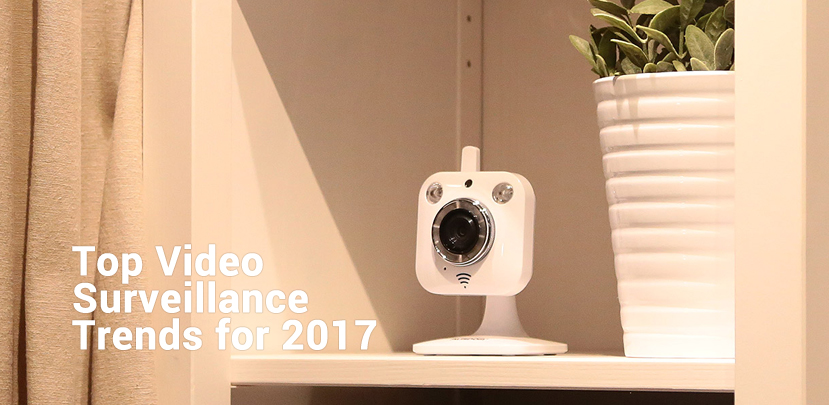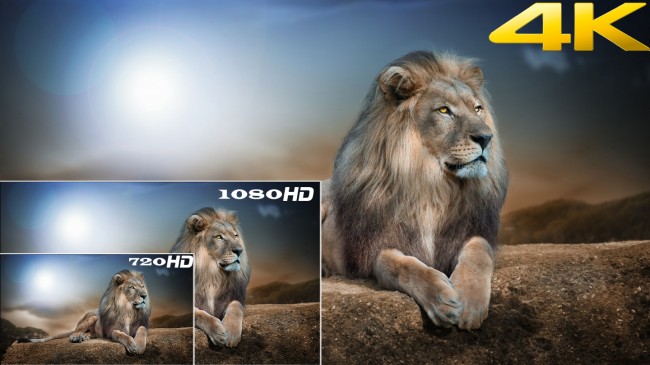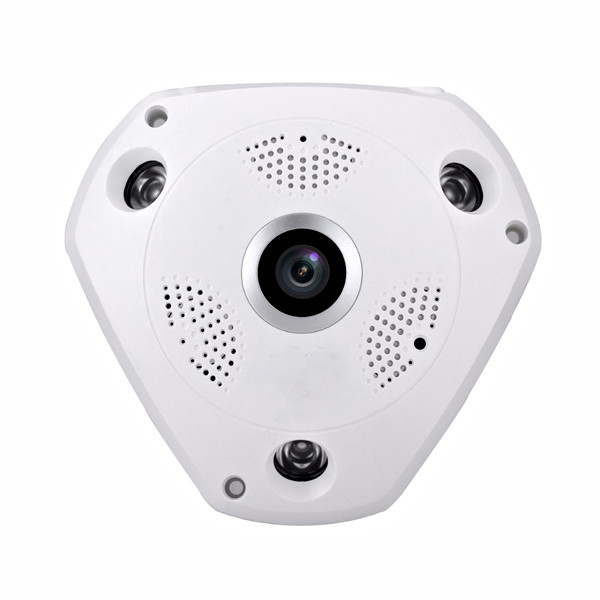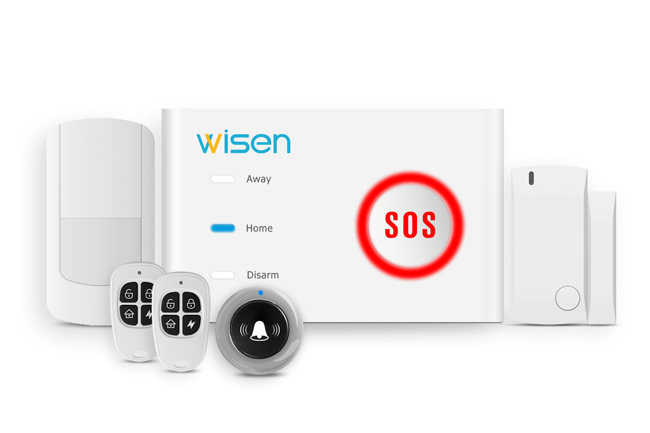
4K H.265 Panoramic Camera Smart Video Analytics - 2017 Market Trend.
When we look back the market trends in 2016, we can conclude that 2016 is the transition year that many new technologies started to appear in the market. Firstly, the image resolution of video surveillance has reached to ultra high definition, which is what we usually call it 4K, then the High Efficiency Video Coding(HEVC)/H.265 becomes hot in 2MP-4K network cameras. The another trend is panoramic cameras gradually accepted by users and inevitably created another niche market.
Catering the right products to the future market is the key to successful business. We, the manufacturers are eager to know what the trend will be in the forthcoming 2017. Undoubtedly, 4K, H.265, panoramic camera, as well as the smart video analytics are popular technologies will be advocated by manufacturers. In the next couple of years, we likely to see the continuation of these long-term trends in the video surveillance market, they will keep moving forward then become the dominate trend just like the transition from standard definition analog CCTV system to high definition digital video surveillance system.
4K video surveillance
Though 4K video surveillance has been repeatedly touted as a major trend in video surveillance for the last year, however it’s still in its early adopter stage. 4K or 2160P, it’s a resolution format that deliver four times higher resolution what your conventional 1080p network camera can shoot. 4K is also called the “Ultra High Definition”, and 8K has been approved to become the standard in cinema industry, but hasn’t been merged into security video surveillance. Generally, 4K resolution so far is the highest resolution that a security camera can deliver.
Is Ultra High Definition equal to 4K?
Technically, "Ultra High Definition" is actually a derivation of the 4K digital cinema standard. However while your local multiplex shows images in native 4096 x 2160 4K resolution, the new Ultra HD consumer format has a slightly lower resolution of 3840 X 2160.

Huge difference between 4K and 1080P?
Consumers keep pursuing higher image resolution in TV industry, they also want their video surveillance system can capture high definition video that including every details that considerably important, 4K means the highest image quality, larger area coverage, but 4K doesn’t necessarily bring you the best performance. As there are many technical reasons that limited the adoption of 4K video surveillance, these factors including encoding capability, light sensitivity, and bandwidth, as well as the compatibility support from back-end decoding devices such as the computer, monitor.
Lastly, similar to your television, you'll only be able to see the resolution difference on a 4K video if you're 1) your camera and the NVR/decoder supports 4K video and 2)you are sitting close enough, or 3) digital zoom in to see the detail.
Encoding capability of network cameras
Encoding is a process that camera compress several images in a second according to different video compression standard, the standard includes regular MJPEG, H.264 and H.265. Encoding capability is mainly determined by the hardware design of the image processor. For example, a Hi3518E supports maximum 720P@30fps encoding capability, and Hi3516C can deliver maximum 1080P@30fps video stream, while the latest Hi3519 can achieve 4K@30fps + 2K@30fps video encoding. If the hardware is the same, higher resolution of image, the fewer frames it can process. This means if the Hi3516C camera capture the video at 720p resolution, then the maximum frame rate can be 60fps.
Why real-time & high frame rate is important?
Currently, not all 4K cameras can deliver real-time frame rate which is 25/30fps. Most 4K IP camera can shoot the video with low frame rate such as 5fps, 12fps, 15fps. When camera shoots the static object, non-real time frame rate can meet the needs to the regular video surveillance application, users can’t feel or see any difference whether the video is 12fps or 25fps. But when camera shoots the fast moving object, the low frame rate will cause motion blur, also missing frame that lacking of some details.
High frame rate is important feature when users want to choose a camera to capture the fasting moving object. Sony, the global HD network security solution provider, has a high frame rate network camera that can deliver 1080p@60fps or 720p@120fps video. A brief summary, when looking at the 4K network camera, making sure to get one that truly support real-time frame rate at 4K image resolution.
Light sensitivity the key to 24 hours video surveillance
Unlike consumer camcorders, the security camera should operate in 24 hours manner, even in the darkness lighting condition, the camera should see the objects clearly. This requires either the camera to have a very high light sensitivity or use the artificial lighting. Infrared illuminators can help camera to shoot the video at night or in low illumination environment. However, the artificial lighting also bring some troubles. These troubles can be excessive heat generated by the working IR LEDs, which is a potential defect may impact on your camera’s reliability and performance. The lifetime of the IR illuminators sometime may cause the trouble, poor quality IR illuminators may gradually die after usage of 2 years. As long as the IR illuminators stop working, your camera will lose the night vision capability, fixing this problem is also quite annoying.
Some experts mentioned that the excessive heat generated by the IR illuminators could greatly impact the imaging process of the image sensor. A really good camera may have two or three independent PCB boards, the CMOS image sensor and the core processor are located in different boards to avoid this problem.
“Day&night surveillance”, but if the camera relies on Infrared illuminators to provide the night vision capability, then the night image inevitably becomes the black/white. In addition to the excessive heat and B/W image problem.
Though Infrared ray is invisible to human, but directly see the Infrared rays for a long time may harmful to human eyes. In some applications such as baby monitoring, people usually don’t want to use the cameras has the Infrared illuminators, or want to switch it off at night. Consequently, if the camera doesn’t feature high light sensitivity, it can’t see the objects clearly under the low illumination condition.
In summary, IR cameras can bring you considerably the cost-effective 24 hour video surveillance. If you wanna a reliable 24 hours video surveillance system, then you may consider use the high-end security cameras which its image sensor featuring excellent light sensitivity. They usually have some special names such as low illumination camera, starlight camera, starvis camera etc.
What’s the Starvis camera?
Starvis, is the registered trade mark for Sony CMOS image sensors which integrating the newest imaging technology can enhance light sensitivity, it’s the mark shows that the image sensor offers high light sensitivity, hence it can capture image in dim lighting environment. Is your camera a Starvis camera? Well, to answer this question is quite simple, just checking what the type of CMOS image sensor that the camera uses. IMX224, IMX225, IMX290, IMX291, IMX123, IMX178, IMX274, ISX017 are Sony Starvis CMOS image sensor. Different from IR cameras, Starvis camera is able to capture color image at night.
Despite the CMOS image sensor, camera lens also play an important role on camera’s light sensitivity. F number, or the aperture controls how much light can pass through the lens, the bigger of the F number, the less light can pass. This means if you want to have a good light sensitivity camera, the camera’s lens should be with small F number or big aperture. This is similar to digital camera, shooting photos in the day time, you can use a F5.6 lens, but shooting at night then you have to use F1.8 lens.
Demand for panoramic security camera will grow rapidly in 2017
Panoramic camera, herein we don’t talk about the action sports camera or panoramic camera that fits on iPhone, iPad. Panoramic cameras as the new type of security camera goes viral quickly after many people realize its irresistible benefits. Typically, a panoramic camera either utilizes a single 360 degree fisheye lens or multiple lenses to shoot the panoramic video. Dewarpping technology can correct the image distortion and convert the 3D image to 2D flat viewing image. Image-stitching technology will be used to form the panoramic image for the multiple lenses type panoramic camera.
There are many reasons why panoramic cameras go viral. The core commitment that the panoramic camera can deliver including 360 degree surrounding view no blind spot, a camera can have the entire room covered, ePTZ function can allow users to rotate the image or zoom in to check the details, 2D or flat view mode fits video surveillance purpose. Today, users can use the App to experience the beauty of panoramic camera. Panoramic + ePTZ can bring a kind of 3D VR experience, therefore some companies call their products as the VR cameras.

Difference between single fisheye lens and multiple lenses
Multiple lenses type of panoramic cameras are pricey, single lens type is inexpensive. However, the former can provide better performance when comparing on the image quality. We recommend users to choose the single lens panoramic camera that is capable of delivering higher image resolution. 1.3-megapixel resolution can meet the need from residential users, while professional users may choose the panoramic camera that can provide up to 6-megapixel resolution image.
Why should I care about H.265?
H.265 is the next generation video compression standard, this standard fits every multimedia industry including broadcast, digital media, cinema, now the video surveillance. Compared with its predecessor H.264, the new standard promises to double the video compression ratio on the premise that retaining the highest image quality. In conclusion, H.265 can enable your camera deliver higher image resolution video under lower network bandwidth or vice versa. As a result, the reduced file size can save up to 50% video storage. By utilizing the H.265 video surveillance equipment, you can save 50% budget on the investment of network infrastructure and video storage.
To take advantage of this technology, the front-end camera and back-end equipment both should support the H.265 standard. A camera that delivers H.265 video should connect to the H.265 NVR.
What’s the difference between MJPEG, H.264 and H.265?
The main difference between H.264 and MJPEG is that MJPEG only compresses individual frames of video, while H.264 compresses across frames. MJPEG is the compilation of separately compressed JPEGs in a sequence, which leads to high quality outcome in terms of resolution. This means MJPEG can retain the highest image quality and detail but with big file size. H.265 can double the compression ratio comparing with the existing H.264 standard, hence reducing 50% file size.
Video surveillance as a service (VSaaS)
Security companies are transferring themselves from selling hardware to offering the security service. Video surveillance as a service (VSaaS) may vary from different companies, currently we have cloud storage service and the smart video analytics, they become more and more popular. Thinking that you can make the profit through offering service rather than the physical hardware devices. It must be a lucrative business mode.
Despite the security & privacy concern, some users opted for a HD camera which offers cloud storage. Though most security cameras can support microSDHC/TF memory card for on-board storage, some users still wanna access the recorded video from anywhere, anytime. Cloud storage makes this become a reality. Just paying a little monthly recurring fee, the camera will upload the video footage to the remote server, video data retrieving is very easy. Since the video surveillance data is huge, the cloud camera only upload the video clips when it detects abnormal activity, making the video surveillance to be smart and efficient.
Facial recognition, it’s one of type video analytics function that some smart cameras can offer. When the camera detects a human face, it can recognize his face then analysis to determine if you have a stranger or intruder in your house. Other smart video analytics such as object counts can allow you to know the number of customers that enter into your shop daily, monthly, or yearly. Some companies even can provide statistics service that based on camera and its advanced video analytics function, such as providing the gender and age info. Video analytics can not only make your video surveillance become more intelligent and easier, if you run your own business, it also may increase your sales and help to grow your business.
IoT - connected security system
IoT is technological evolution based on how connected devices can be used to enhance communication, automate complex industrial processes, and make cities and homes smarter. According to IHS there will be 25 billion smart appliances, wearables, game players, and other consumer devices connected to the Internet of Things (IoT) by 2025.The residential security market has already been fundamentally changed by the IoT. This trend helps the connected DIY products to become popular among residential users. Now, many companies offer the connected intrusion alarm system that based on WiFi technology. E.g. Wisen alarm system which combines the GSM cellular and WiFi technology together, which is able to send push notification and SMS to users in case it triggers an alarm. WiFi connectivity not only makes the alarm monitoring become much convenient & easier, also greatly reduces the running cost or maintenance fee.

Today, people are willing to buy a IoT or smart home automation system which can allow remote controlling via the smartphone or tablet. In addition to home appliance control, the latest home automation system may includes other functionalities such as video surveillance, intrusion security protection, thermostat, as well as the electricity/gas usage measurement. Simplifying your live is the IoT's ultimate goal. We expect during the next several years, users can control the different connected devices from the single platform or App.
Get My Latest Posts
Subscribe to get the latest updates.
Your email address will never be shared with any third parties.